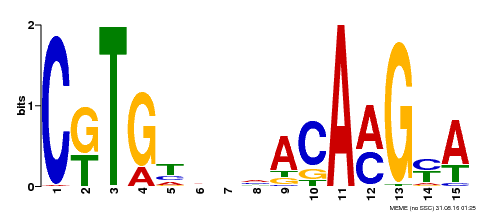- Riechmann JL, et al.
Arabidopsis transcription factors: genome-wide comparative analysis among eukaryotes.
Science, 2000. 290(5499): p. 2105-10
[PMID:11118137] - Yamada K, et al.
Empirical analysis of transcriptional activity in the Arabidopsis genome.
Science, 2003. 302(5646): p. 842-6
[PMID:14593172] - Ooka H, et al.
Comprehensive analysis of NAC family genes in Oryza sativa and Arabidopsis thaliana.
DNA Res., 2003. 10(6): p. 239-47
[PMID:15029955] - Woo HR,Kim JH,Nam HG,Lim PO
The delayed leaf senescence mutants of Arabidopsis, ore1, ore3, and ore9 are tolerant to oxidative stress.
Plant Cell Physiol., 2004. 45(7): p. 923-32
[PMID:15295076] - Duarte JM, et al.
Expression pattern shifts following duplication indicative of subfunctionalization and neofunctionalization in regulatory genes of Arabidopsis.
Mol. Biol. Evol., 2006. 23(2): p. 469-78
[PMID:16280546] - He XJ, et al.
AtNAC2, a transcription factor downstream of ethylene and auxin signaling pathways, is involved in salt stress response and lateral root development.
Plant J., 2005. 44(6): p. 903-16
[PMID:16359384] - Ascencio-Ib
Global analysis of Arabidopsis gene expression uncovers a complex array of changes impacting pathogen response and cell cycle during geminivirus infection.
Plant Physiol., 2008. 148(1): p. 436-54
[PMID:18650403] - Kim JH, et al.
Trifurcate feed-forward regulation of age-dependent cell death involving miR164 in Arabidopsis.
Science, 2009. 323(5917): p. 1053-7
[PMID:19229035] - Chen T, et al.
Effects of tobacco ethylene receptor mutations on receptor kinase activity, plant growth and stress responses.
Plant Cell Physiol., 2009. 50(9): p. 1636-50
[PMID:19608714] - Carviel JL, et al.
Forward and reverse genetics to identify genes involved in the age-related resistance response in Arabidopsis thaliana.
Mol. Plant Pathol., 2009. 10(5): p. 621-34
[PMID:19694953] - Balazadeh S, et al.
A gene regulatory network controlled by the NAC transcription factor ANAC092/AtNAC2/ORE1 during salt-promoted senescence.
Plant J., 2010. 62(2): p. 250-64
[PMID:20113437] - Balazadeh S,Wu A,Mueller-Roeber B
Salt-triggered expression of the ANAC092-dependent senescence regulon in Arabidopsis thaliana.
Plant Signal Behav, 2010. 5(6): p. 733-5
[PMID:20404534] - Balazadeh S, et al.
ORS1, an H₂O₂-responsive NAC transcription factor, controls senescence in Arabidopsis thaliana.
Mol Plant, 2011. 4(2): p. 346-60
[PMID:21303842] - Kim JI, et al.
YUCCA6 over-expression demonstrates auxin function in delaying leaf senescence in Arabidopsis thaliana.
J. Exp. Bot., 2011. 62(11): p. 3981-92
[PMID:21511905] - Hur Y,Kim JH,Lee DJ,Chung KM,Woo HR
Overexpression of AtCHX24, a member of the cation/H⁺ exchangers, accelerates leaf senescence in Arabidopsis thaliana.
Plant Sci., 2012. 183: p. 175-82
[PMID:22195591] - Vogelmann K, et al.
Early senescence and cell death in Arabidopsis saul1 mutants involves the PAD4-dependent salicylic acid pathway.
Plant Physiol., 2012. 159(4): p. 1477-87
[PMID:22706448] - Trivellini A, et al.
Carbon deprivation-driven transcriptome reprogramming in detached developmentally arresting Arabidopsis inflorescences.
Plant Physiol., 2012. 160(3): p. 1357-72
[PMID:22930749] - Renault H, et al.
γ-Aminobutyric acid transaminase deficiency impairs central carbon metabolism and leads to cell wall defects during salt stress in Arabidopsis roots.
Plant Cell Environ., 2013. 36(5): p. 1009-18
[PMID:23148892] - Matallana-Ramirez LP, et al.
NAC transcription factor ORE1 and senescence-induced BIFUNCTIONAL NUCLEASE1 (BFN1) constitute a regulatory cascade in Arabidopsis.
Mol Plant, 2013. 6(5): p. 1438-52
[PMID:23340744] - Rauf M, et al.
ORE1 balances leaf senescence against maintenance by antagonizing G2-like-mediated transcription.
EMBO Rep., 2013. 14(4): p. 382-8
[PMID:23459204] - Li J,Chen X,Luo LQ,Yu J,Ming F
[Functions of ANAC092 involved in regulation of anther development in Arabidopsis thaliana].
Yi Chuan, 2013. 35(7): p. 913-22
[PMID:23853363] - Pei H, et al.
An NAC transcription factor controls ethylene-regulated cell expansion in flower petals.
Plant Physiol., 2013. 163(2): p. 775-91
[PMID:23933991] - Manacorda CA, et al.
Salicylic acid determines differential senescence produced by two Turnip mosaic virus strains involving reactive oxygen species and early transcriptomic changes.
Mol. Plant Microbe Interact., 2013. 26(12): p. 1486-98
[PMID:23945002] - Khan M,Rozhon W,Poppenberger B
The role of hormones in the aging of plants - a mini-review.
Gerontology, 2014. 60(1): p. 49-55
[PMID:24135638] - Du J, et al.
Nitric oxide induces cotyledon senescence involving co-operation of the NES1/MAD1 and EIN2-associated ORE1 signalling pathways in Arabidopsis.
J. Exp. Bot., 2014. 65(14): p. 4051-63
[PMID:24336389] - Ding Y, et al.
Four distinct types of dehydration stress memory genes in Arabidopsis thaliana.
BMC Plant Biol., 2013. 13: p. 229
[PMID:24377444] - Kim HJ, et al.
Gene regulatory cascade of senescence-associated NAC transcription factors activated by ETHYLENE-INSENSITIVE2-mediated leaf senescence signalling in Arabidopsis.
J. Exp. Bot., 2014. 65(14): p. 4023-36
[PMID:24659488] - Bohner A,Kojima S,Hajirezaei M,Melzer M,von Wirén N
Urea retranslocation from senescing Arabidopsis leaves is promoted by DUR3-mediated urea retrieval from leaf apoplast.
Plant J., 2015. 81(3): p. 377-87
[PMID:25440717] - Qiu K, et al.
EIN3 and ORE1 Accelerate Degreening during Ethylene-Mediated Leaf Senescence by Directly Activating Chlorophyll Catabolic Genes in Arabidopsis.
PLoS Genet., 2015. 11(7): p. e1005399
[PMID:26218222] - Sakuraba Y,Bülbül S,Piao W,Choi G,Paek NC
Arabidopsis EARLY FLOWERING3 increases salt tolerance by suppressing salt stress response pathways.
Plant J., 2017. 92(6): p. 1106-1120
[PMID:29032592] - Gao Z, et al.
KIRA1 and ORESARA1 terminate flower receptivity by promoting cell death in the stigma of Arabidopsis.
Nat Plants, 2018. 4(6): p. 365-375
[PMID:29808023] - Kim H, et al.
Circadian control of ORE1 by PRR9 positively regulates leaf senescence in Arabidopsis.
Proc. Natl. Acad. Sci. U.S.A., 2018. 115(33): p. 8448-8453
[PMID:30065116] - Oh SA, et al.
Identification of three genetic loci controlling leaf senescence in Arabidopsis thaliana.
Plant J., 1997. 12(3): p. 527-35
[PMID:9351240]
|





